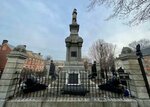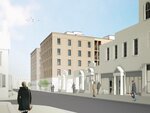The Germantown Urban Village Historic District was unanimously designated by the Philadelphia Historical Commission on Friday.
This item is available in full to subscribers.
We have recently launched a new and improved website. To continue reading, you will need to either log into your subscriber account, or purchase a new subscription.
If you are a digital subscriber with an active subscription, then you already have an account here. Just reset your password if you've not yet logged in to your account on this new site.
If you are a current print subscriber, you can set up a free website account by clicking here.
Otherwise, click here to view your options for subscribing.
Please log in to continue |




The Germantown Urban Village Historic District, nominated to the city’s register of historic places by preservationist and architectural historian Oscar Beisert in October, was unanimously designated by the Philadelphia Historical Commission on Friday.
As a result, buildings within the district are protected from demolition, and any new buildings or exterior alterations must be reviewed and approved by the Philadelphia Historical Commission.
The highlight of the new historic district is Market Square, which has served as a central open space for the community for more than a century and is the heart of Germantown’s commercial center.
Market Square, first created in 1703 to include a pound and a log prison in the southeast corner, is now home to the Soldiers Monument, which was erected in 1883 to commemorate Union Civil War soldiers. It sits on a pedestal made from Gettysburg granite and is surrounded by a fence constructed out of musket barrels and bayonets. It is encircled by the historic Deshler-Morris House, German Reformed Church, and Fromberger-Harkness House, which is the current site of Historic Germantown.
“We feel, of course, that almost all of Germantown deserves protection,” said Historic Germantown executive director Tuomi Forrest at the meeting. “But if we're going to start somewhere, there's no better place than this.”
The district also includes buildings and sites on Germantown Avenue, Church Lane, Lena Street, and East and West School House Lane, including the Ashmead House at 5430 Germantown Ave., the Saving Fund Society of Germantown at 5452-58 Germantown Ave., and Hamill Mill Apartments at 5423-27 Lena St.
Community support for the district was overwhelming.
“There really is no more historic place in the entire city,” resident Mason Carter said. “We’d lose something if we didn't keep this all intact in one piece, and I think that there's no other place in the city that has had such a continuous history as this area.”
Another commenter, Jim Duffin, called the historic district the “core of the community of Germantown.”
“This is an incredibly important area of Germantown and deserves careful consideration and protection for the future because of the long history that dates from the 17th century, into the 20th century and 21st century, and all the institutions and things here,” he said. “I can't [stress any] more how significant this particular part of Germantown is and how important it is to add this district to the register.”
Development at Church Lane
The district’s designation complicates plans for Olympia Holdings, a development company seeking to construct a five-story, 33-unit building within the district on Church Lane.
Olympia’s proposed development conforms to city zoning and does not require any zoning variances, so residents could not use that process to object to the project. But the historic status means that Olympia must now get permission from the Historical Commission in order to proceed.
The company went before the Historical Commission in January to seek approval for its project while the Germantown Urban Village Historic District was undergoing its approval process. At the time, it was met with hostility from neighbors and the Historical Commission’s architectural committee. The building’s design, they said, did not fit within Germantown’s historic context.
Olympia presented its updated plans for 26-34 Church Lane, which is currently a parking lot, to the Historical Commission at the same Friday meeting. The new plan for the building features a ground-floor storefront and has dispensed with an open-air waiting area on the building’s easternmost side. The new design also swaps out casement windows for double-hung, divided light windows.
“We wanted to demonstrate that we were willing to be sensitive to some of the concerns regarding stylistic choices,” said architect Kevin O’Neill, “and hopefully create a project that fits in nicely within the neighborhood and not visually detract in any way from its context.”
The design was improved, the commission said, but still needs work.
“Architecturally the design has improved significantly, but there is a question about the massing,” said Historical Commission member Dan McCoubrey.
As a result, the commission voted in favor of sending the development team back to the commission’s architectural committee so the proposal can go through one more round of revisions at a later date.
However, Olympia representative Eli Kantrovitz said if the building was made any smaller, it would no longer be profitable to build. He also noted that while Olympia typically builds more “modern” buildings, his company opted for a completely different design for 26-34 Church Lane in an effort to make it better fit Germantown’s historic context.
“[We’re] trying to work with you to match the design to… a more traditional style rather than a modern style,” he said. “That costs us much more.”